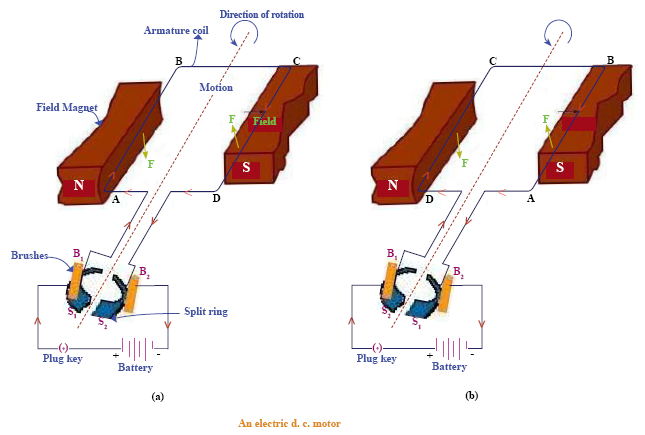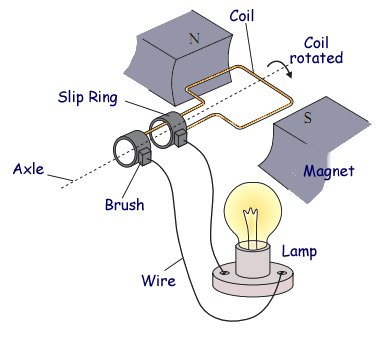Electric Motors: Difference between revisions
No edit summary |
No edit summary |
||
| Line 1: | Line 1: | ||
This page covers motors and generators | This page covers motors and generators | ||
Claimed by Komal Hirani: khirani6 | Claimed by Komal Hirani: khirani6 | ||
| Line 13: | Line 14: | ||
Commercial generators rotate a loop of wire in a magnetic field rather than moving a bar back and forth. This has the same effect of achieving a charge separation along part of the rotating loop, but rotary motion is much easier to arrange mechanically, and with relatively low friction on the axle. | Commercial generators rotate a loop of wire in a magnetic field rather than moving a bar back and forth. This has the same effect of achieving a charge separation along part of the rotating loop, but rotary motion is much easier to arrange mechanically, and with relatively low friction on the axle. | ||
[[File:diagram3.png]] | |||
==Examples== | ==Examples== | ||
==Connectedness== | ==Connectedness== | ||
Revision as of 14:58, 5 December 2015
This page covers motors and generators
Claimed by Komal Hirani: khirani6
The Main Idea
Electric Motors
Our everyday routines heavily rely upon the electric motors in common applications such as refrigerator compressors, water pumps, elevators, clocks, and cars. Electric motors are a common application of the torque that a magnetic field exerts on a current-carrying coil. In order for motors to function the way that they do, the current-carrying coil needs to turn continuously. In order for the current-carrying coil to turn in such a way, you need to make electrical connections to the coil in such a way that just as it is coming to its stable position, you reverse the direction of the current. A simple way to achieve this continuos motion is through a "split-ring commutator" that automatically changes the direction of the current through the coil at just the right moment. Metal tabs make contact between the battery and the commutator, which allows current to flow and for the motor to rotate.
Below is a picture that shows the overall design of a single-loop motor driven by direct current (DC):
Electric Generators
Commercial generators rotate a loop of wire in a magnetic field rather than moving a bar back and forth. This has the same effect of achieving a charge separation along part of the rotating loop, but rotary motion is much easier to arrange mechanically, and with relatively low friction on the axle.
Examples
Connectedness
- How is this topic connected to something that you are interested in?
- How is it connected to your major?
- Is there an interesting industrial application?
History
Put this idea in historical context. Give the reader the Who, What, When, Where, and Why.
See also
Are there related topics or categories in this wiki resource for the curious reader to explore? How does this topic fit into that context?
Further reading
Books, Articles or other print media on this topic
External links
Internet resources on this topic
References
https://www.grc.nasa.gov/www/k-12/airplane/thermo0.html http://hyperphysics.phy-astr.gsu.edu/hbase/thermo/thereq.html

